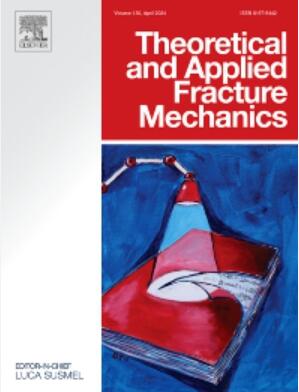饱和脆性岩石微裂纹扩展对压缩破裂的冻结效应
IF 5.6
2区 工程技术
Q1 ENGINEERING, MECHANICAL
引用次数: 0
摘要
微裂纹扩展对饱和脆性岩石压缩破裂行为的冻结效应对寒区地下工程的安全稳定性评价具有重要意义。然而,冻结饱和脆性岩石压缩破坏的微观宏观断裂机制尚不清楚。本文旨在建立考虑冻结效应的饱和脆性岩石微宏观断裂模型。该模型将低温相关断裂韧性KIC、摩擦系数μ、骨架收缩应力Pt、冻胀应力Pf、裂纹表面内聚应力Pc等参数整合到原有的机翼微裂纹扩展模型中。提出了一种考虑冻结效应的改进翼裂尖端应力强度因子。结合提出的应力强度因子、岩石断裂准则和裂纹-应变损伤关系,研究冻结对饱和岩石应力-应变曲线和抗压强度的影响。冻结效应降低了孔隙压实阶段,峰值前应力-应变曲线的凹趋势逐渐消失。此外,与室温相比,在渐进压缩破坏过程中,抗压强度增加。通过已发表的实验验证了模型结果的有效性。讨论了不同温度下围压和微裂纹特性对岩石抗压强度的影响。研究饱和脆性岩石在压缩作用下的冻结强化机制,对寒区工程设计和安全评价具有重要意义。本文章由计算机程序翻译,如有差异,请以英文原文为准。
Frozen effect of microcrack growth on compressive fracture in saturated brittle rocks
The frozen effect on compressive fracture behavior in saturated brittle rocks, induced by microcrack propagation, is crucial for assessing the safety and stability of underground engineering projects in cold regions. However, the micro–macro fracture mechanism remains unclear during compressive failure in frozen saturated brittle rocks. This paper aims to develop a micro–macro fracture model with the frozen effect in saturated brittle rocks. This model is formulated by combining the low temperature-dependent fracture toughness KIC, friction coefficient μ, skeleton contractile stress Pt, frost heave stress Pf, and cohesive stress Pc between crack surfaces into the previous wing microcrack growth model. An improved stress intensity factor at wing crack tips, incorporating the frozen effect, is proposed. This study investigates the frozen effects on saturated rock’s stress–strain curve and compressive strength by combining the proposed stress intensity factor, rock fracture criterion, and crack-strain damage relation. The frozen effect reduces the pore compaction phase, as evidenced by the gradual disappearance of the concave trend in the pre-peak stress–strain curve. Additionally, compressive strength increases compared to room temperature during progressive compressive failure. The validity of the presented model results is verified through published experiments. The effects of confining pressure and microcrack characteristics on the compressive strength of rocks are discussed at different temperatures. Under compression, the frozen strengthening mechanisms of saturated brittle rocks offer valuable insights for the design and safety evaluation of cold-region engineering projects.
求助全文
通过发布文献求助,成功后即可免费获取论文全文。
去求助
来源期刊

Theoretical and Applied Fracture Mechanics
工程技术-工程:机械
CiteScore
8.40
自引率
18.90%
发文量
435
审稿时长
37 days
期刊介绍:
Theoretical and Applied Fracture Mechanics'' aims & scopes have been re-designed to cover both the theoretical, applied, and numerical aspects associated with those cracking related phenomena taking place, at a micro-, meso-, and macroscopic level, in materials/components/structures of any kind.
The journal aims to cover the cracking/mechanical behaviour of materials/components/structures in those situations involving both time-independent and time-dependent system of external forces/moments (such as, for instance, quasi-static, impulsive, impact, blasting, creep, contact, and fatigue loading). Since, under the above circumstances, the mechanical behaviour of cracked materials/components/structures is also affected by the environmental conditions, the journal would consider also those theoretical/experimental research works investigating the effect of external variables such as, for instance, the effect of corrosive environments as well as of high/low-temperature.
 求助内容:
求助内容: 应助结果提醒方式:
应助结果提醒方式:


